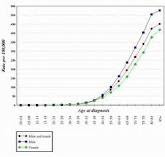 Survival rates are often used by doctors as a standard way of discussing a person's prognosis (outlook). Some patients may want to know the survival statistics for people in similar situations, while others may not find the numbers helpful, or may even not want to know them.
Survival rates are often used by doctors as a standard way of discussing a person's prognosis (outlook). Some patients may want to know the survival statistics for people in similar situations, while others may not find the numbers helpful, or may even not want to know them.The 5-year survival rate refers to the percentage of patients who live at least 5 years after their cancer is diagnosed. Of course, many people live much longer than 5 years (and many are cured).
In order to get 5-year survival rates, doctors have to look at people who were treated at least 5 years ago. Improvements in treatment since then may result in a more favorable outlook for people now being diagnosed with colon cancer.
Survival rates are often based on previous outcomes of large numbers of people who had the disease, but they cannot predict what will happen in any particular person's case. Knowing the type and the stage of a person's cancer is important in estimating their outlook. But many other factors may also affect a person's outlook, such as the grade of the cancer, the genetic changes in the cancer cells, and how well the cancer responds to treatment. Even when taking these other factors into account, survival rates are at best rough estimates.